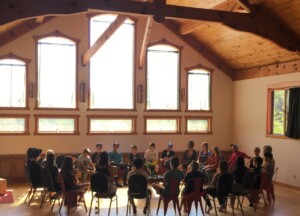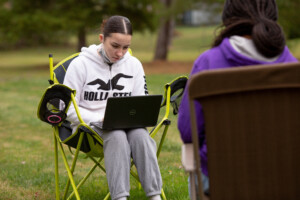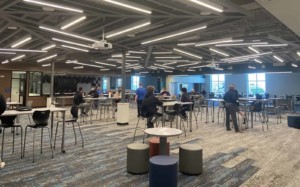Microschools: Change on the Fringe or Reshaping the Ecosystem?

By: Anne Olderog
“Without the little ideas, there are no big ideas,” Twyla Sharp famously said. Tanner Christensen’s mantra is that big ideas start small. Are the smallest entities in education – microschools in their various forms — poised to become the next big idea in education?
First, there were just a few pods (in Brooklyn). Then, they were all over the country with education professionals in the field beginning to speculate that microschools could lead to macro change across the education system we once knew. Now, as society begins to rebuild after COVID-19, it is worth re-exploring where we’re at. Should educators dismiss microschools as a fringe phenomenon – or is this a wave to be reckoned with? More importantly, how do microschools influence education outside of themselves – and do they have the potential to ultimately reshape the ecosystem?
Today, some of the same advantages of microschools serve as an antidote to what education has become – built on the model of Fordian industrialization, process-driven, efficiency-seeking, bell-tolling, and regimented. Microschools refreshingly favor small classroom sizes, personal attention, and the allowance for students to explore – and express – individuality, and ultimately forge their own learning paths forward. As a student from the one-room schoolhouse Acton Academy aptly said, “Acton is a place where you do not have to hide your weirdness.”
Are microschools, though, something that is only possible for the elite few, or can they be implemented successfully on a mass scale? To answer this, it is helpful to understand the interplay of different business models within education. In his seminal book, The Interaction Field, Erich Joachimsthaler explores different value creation models. The first one, the pipeline, is predicated on the traditional value chain – in learning, think of education as an industry, managing a range of physical assets, in a linear way – institutions hire value providers (instructors) who in turn “deliver” education “goods” to students. The second model, the “digitized” one, simply transposes the offline model online, offering a number of efficiency advantages. Just like first-generation e-books simply digitized physical assets, new business models such as MOOCs (Coursera or Udacity’s nano-degree programs) transposed offline courses online, making them accessible to a much larger public – with great success, as shown by Coursera’s $7 billion IPO.
This post will argue that microinstitutions – in K-12 and Higher Ed – are well poised to become true interaction fields or business models that leverage value created by interactions. This will, in turn, make the third wave of digital business models a reality in education.
Why are microschools – and microinstitutions – ideally suited for this new model?
Recent Vivaldi research indicates that relationships are one of the primary motivators in education – the relationship between student and teacher, or mentor, is as old as Socrates and Plato. Psychologist Benjamin Bloom references in his 2 sigma paradox the benefits of one-on-one learning and tutoring. However, it was never made clear if what made the difference to learners were more tailored explanations in a one-on-one mentorship setting or the presence and support of a caring adult.
One of the most efficient ways of organizing a community is to structure it by tribes, something that megachurches knew from the times of Willow Creek – just like Facebook quickly became driven by groups, or Reddit became organized by sub-communities.
Erich Joachimsthaler argues that the most successful communities and platforms bind with existing networks and are structured in tribes or sub-communities – this is what allows them to navigate the tension between intimacy and scale, allowing for reach while at the same time creating powerful connections. They also harness collective intelligence and give users a sense of collaborating on solving really big problems – in this case, reinventing education for tomorrow. There are several models of platforms for microschools, which indicate several ways in which these can reshape the ecosystem.
The first is simply a search or matching engine – allowing to find a microschool easier and creating a larger market of potential families and guides. One example is Schoolhouse that allows finding microschools and connects microschools with potential teachers, creating efficiencies in identifying, matching, and recruiting potential candidates. As in other markets, an easier process is one of the elements that can help bring microschools over the chasm.
Another model is one that integrates microschools into the communities in which they serve – creating a larger network. This is likely to create a “bridge” that connects microschools to the current education system, easing entry and creating more porous boundaries. This effect is akin to some of the “pods” that came into existence last year – as many families explored alternative education options, some came away with the idea that they liked what they found. As boundaries between microschools and mass schools become more porous, this will allow for a better exchange of ideas and practices. For example, Newark Innovation Academy applies alternative, innovative approaches in a public school setting – in a community of about 100 students. In professional education, Hackensack Meridian School of Health, an innovative medical school – and the first new medical school to open in NJ for years – takes the notion of integrating into a community to a different level – students are literally integrated into the surrounding community, allowing them to follow families and community members over time, gaining valuable experience and practical insights into public health challenges.
A third model altogether is pioneered by Prisma – a disruptive platform created by former Google execs. One of the successful strategies of building a platform is to carve out a new space – the way Peloton owns connected fitness, or Etsy carved out DIY gifts. This is the mission championed by Prisma – “A Connected Learning Network is a new category in K-12 education. It consists of a small cohort of diverse kids learning virtually together with the support and guidance of dedicated learning coaches and a network of these cohorts spread around the world where learners can make friendships, collaborate and share ideas. Our vision is that learners get the best of both worlds: the intimacy and support of a “one-room schoolhouse” (the cohort) and the breadth, diversity, and global perspective of the world’s largest kid-focused learning community (the network)”.
The “one-room schoolhouses” create a network of microschools – removing some of the barriers to creating one in the long run. Ultimately, network effects can help microschools scale – with porous boundaries, overarching networks, and lower barriers to entry – all while preserving the freedom that allows for experimentation.
For more, see:
Anne Olderog is a Partner at Vivaldi, leading projects on growth/innovation strategy, positioning and brand architecture.
Stay in-the-know with innovations in learning by signing up for the weekly Smart Update.




0 Comments
Leave a Comment
Your email address will not be published. All fields are required.